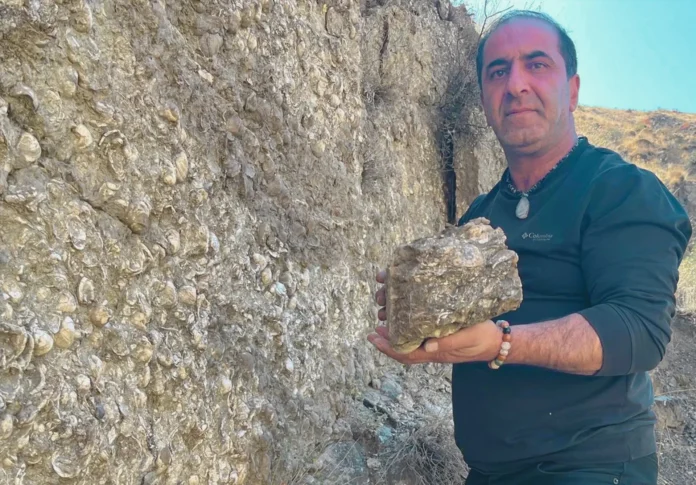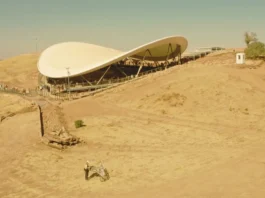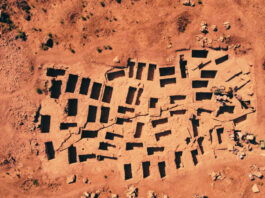In the remote district of Tortum, Erzurum, a stunning scientific discovery has emerged — marine fossils dating back 200 million years have been uncovered by local historian and researcher Oğuzhan Türk.
These fossils, believed to belong to the Tethys Ocean, offer rare insight into a time when the Anatolian region lay beneath ancient waters teeming with marine life.
Oğuzhan Türk, a graduate of Anadolu University’s History Department and Istanbul University’s Cultural Heritage and Tourism Program, has spent years exploring the rugged landscapes of Eastern Turkey. During his extensive fieldwork across more than 700 villages, he meticulously examined geological formations, caves, and stone layers — leading to a breakthrough that could reshape our understanding of the region’s prehistoric environment.
The Jurassic Era Revealed Beneath Erzurum
Guided by geological formation maps published by the General Directorate of Mineral Research and Exploration (MTA), Türk identified a region containing fossil layers from the Lower and Middle Jurassic periods — roughly 200 million years ago.
Among his discoveries were the remains of sea urchins, sea cucumbers, gastropods, coral structures, and even an octopus fossil, remarkably preserved within the stone.
“These are truly fascinating sea creatures,” Türk explained. “We’ve found an incredible diversity of fossils that tell us how vibrant life once was in this area. From the eastern plains to the western ridges, we’ve documented nearly every fossil-rich site along a stretch of 80 kilometers east to west, and 200 kilometers north to south.”
Fossils From the Tethys Ocean
The fossils, now being displayed in Türk’s natural stone workshop in Yakutiye, provide a tangible connection to the long-lost Tethys Ocean, which once divided the ancient continents of Gondwana and Laurasia.
“Every fossil we find here tells a story,” Türk said. “Two hundred million years ago, these creatures swam freely in the ocean that covered what is now Erzurum. It’s astonishing to realize that today’s mountainous terrain was once part of a vast seabed.”
He emphasized the importance of careful preservation, noting that they collaborate with university experts to properly identify and protect each fossil. “We don’t have a strong marine culture here, so many of these fossils are unfamiliar to locals. That’s why we work closely with scientists — to ensure we understand and safeguard this heritage.”

A Vision for a Fossil and Mineral Museum
Recognizing the significance of these findings, Türk is now spearheading efforts to establish a Fossil and Mineral Museum in Erzurum. The project aims to both preserve the fossils and boost tourism and local economy.
“We’re working with Erzurum Metropolitan Municipality Mayor Mehmet Sekmen, who supports the initiative,” Türk said. “A museum like this would not only protect these rare fossils but also attract visitors, scientists, and students from around the world. It could transform Erzurum into a new center for geological and paleontological research.”
Such a museum would mark a turning point for the region — bridging science, culture, and tourism. Experts believe that with proper support, Erzurum could become Turkey’s foremost destination for fossil-based education and exploration.
Why This Discovery Matters
The Erzurum fossils aren’t just relics of the past; they represent an untold story of Earth’s evolution.
The discovery reveals that Eastern Anatolia was once submerged under a prehistoric sea, connecting Turkey’s geological past to global paleontological narratives.
From the perspective of environmental history, this also sheds light on how land formations, climate shifts, and tectonic movements shaped modern Turkey over millions of years.
For students and researchers, these fossils offer a “living textbook” — providing direct evidence of marine biodiversity and evolutionary patterns during the Jurassic period.
Scientific and Economic Impact
Beyond academic interest, the project could have tangible economic benefits.
With growing interest in geotourism, Erzurum’s new fossil sites could draw both domestic and international visitors, much like the famous Pamukkale or Cappadocia regions.
“Every fossil we uncover is not just a piece of history but also a potential source of inspiration,” Türk said. “If we manage to build this museum, it will become a legacy — a place where history, nature, and science coexist.”
A Glimpse Into a Forgotten Sea
The discovery in Erzurum serves as a reminder of how deeply intertwined nature and history truly are.
Beneath its cold mountains and plains lies a fossilized ocean, silently preserving the memory of a world long gone.
As the region prepares to protect and showcase these remains, one thing is certain: the story of Anatolia’s ancient sea has only just begun to surface.



